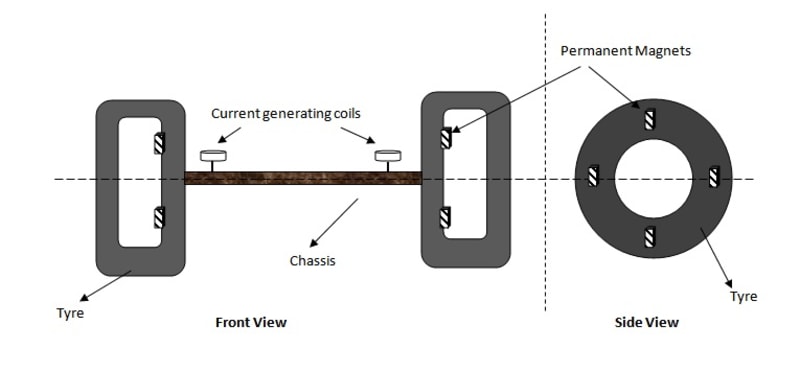Relative motion between a metal conductor and magnetic field generates voltage. This is a well known fact. Also,a magnet moving in relative motion with a coil can induce a current in the coil.
Harnessing this voltage/current to recharge the battery or to power the electrical accessories or in case of a hybrid/electric vehicle can boost the distance traveled.
There are two places in a typical automobile where we have constant movement: first, rotation of tires/wheels and second, steering wheel movement by the driver.
The proposed design will have evenly distributed small size permanent magnets on the periphery of the steering wheel facing the dashboard. On the dashboard,we can have multiple coils located strategically in such a way to increase the current.
Second part of the design is to have a similar arrangement in the tires of the vehicle. Multiple (for ex 4) pieces of permanent magnets are mounted on the inner wall of the tire and these magnets are inside the tire but not outside to avoid damage due to exposure to harsh atmospheric conditions.
Then, on the axle/chassis of vehicle, coils are mounted as is done in the case of the dashboard-steering mechanism described above. When the vehicle is running and tires are rotating at a very high speed, magnets inside the tire induce current in the coils.
By this setup we have 5 sources to generate electricity: one is the dashboard-steering combination and the other 4 are tire-axle combinations.
However, a magnet kept inside the tire cannot generate a very strong field due to isolation by rubber and eventually a very feeble current is generated at the coil mounted on axle or chassis. But the advantage is the very high rotation per minute and having four such combinations on each wheel.
But in case of dashboard-steering wheel setup even we can generate a strong current but movement in the steering wheel is relatively lesser and random.
Overall, this design has the potential to increase mileage in a hybrid vehicle and in current situations worldwide where fossil fuel deposits are shrinking rapidly. Any improvement, however small, is a valuable addition.
This also contributes toward reducing global warming and the green house effect. Quantifying the contribution of the design towards these goals is very difficult at this stage but deployment of the design in vehicle will open avenues for further enhancement in electronics and design. Over a reasonable period of time, we can hope to make the impact larger and felt.
Like this entry?
-
About the Entrant
- Name:Dileep Bhoi
- Type of entry:individual
- Software used for this entry:None
- Patent status:none








